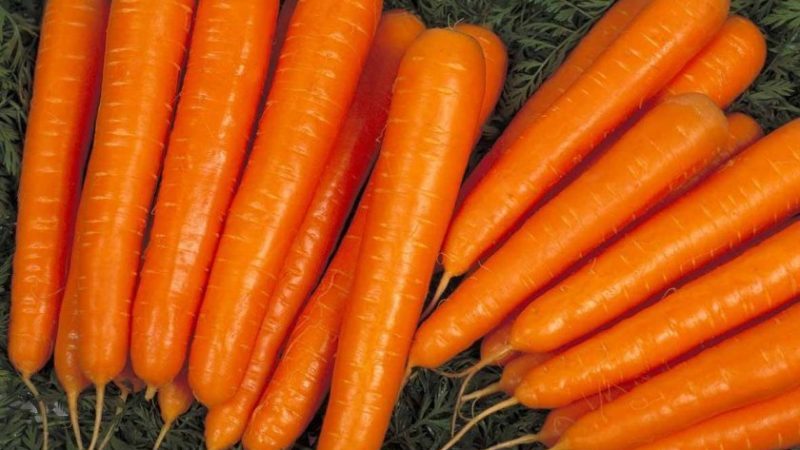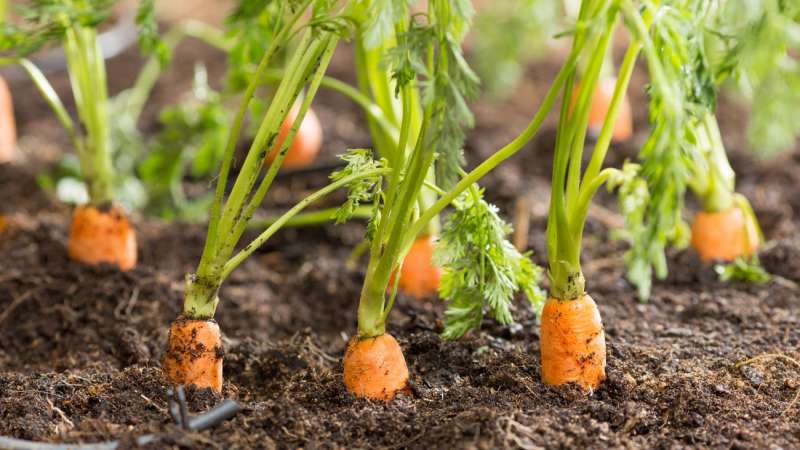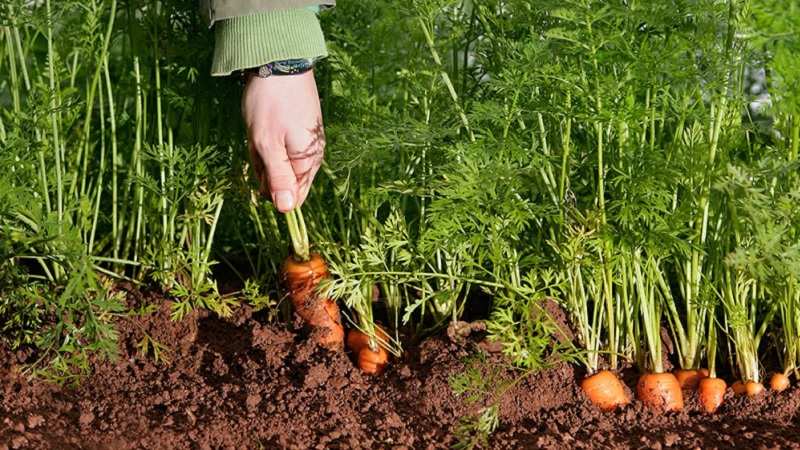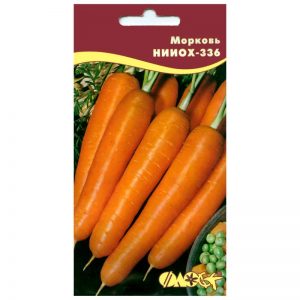Mid-season carrot variety Niiokh 336
The quality and quantity of the harvest of any crop depends not only on caring for it, but also on the choice of a suitable variety. Carrots are no exception. For more than 40 years, vegetable growers have been growing in their garden a mid-season high-yielding variety Niiokh 336. Carrots are universal in use and are rich in carotene.
The content of the article
Description of the variety
Niiokh 336 is a mid-season carrot variety. Differs in high yield and versatility in use: suitable for both conservation and use fresh. Possesses good keeping quality, is stored for a long time.

Origin and development
The breeders of the All-Russian Research Institute of Vegetable Growing received the variety by crossing Vitamin 6 and Hybrid 5 with subsequent selection. In 1978, Niiokh 336 was entered into the State Register of the Russian Federation.
The culture is recommended for cultivation throughout the Russian Federation.
Composition and properties
Carrots are rich in beta-carotene, contain a large amount of polyacetylenes, carotenoids (including alpha-carotene and lutein), hydroxycinnamic acids, which have antitumor and anti-inflammatory properties that form an adequate immune response in the body.
Vitamins in root vegetables:
- A (retinol) is found in the form of beta-carotene. It is beneficial for maintaining healthy eyes, skin, growth and immunity.
- H (biotin) promotes the absorption and processing of proteins in the body. Participates in the metabolism of the skin.
- B6 (pyridoxine) is involved in growth, blood formation and circulation. Normalizes the work of the central nervous system.
- C strengthens the immune system and prevents the development of colds. Has an anti-stress effect.
- E (tocopherol) is involved in protein synthesis and metabolism. Supports the reproductive functions of the body.
- B1 (thiamine) is the most important vitamin for the nervous system. has a positive effect on neuro-reflex regulation.
- B2 (riboflavin) is actively involved in the body's redox reactions.
Due to its high beta-carotene content (23%), carrots have antioxidant properties. Root vegetables reduce the risk of developing cardiovascular disease and improve vision. Suitable for baby and diet food.
Reference. Vitamin A is a fat-soluble substance, so for its absorption, carrots are consumed along with foods high in fat.
Ripening period and yield
Carrots Niiokh 336 are mid-ripening - their vegetation period is 100–120 days. In warm regions, roots ripen faster, in 80–90 days.
The productivity of the crop is high: 28–54 tons of root crops are harvested from 1 hectare.
Disease resistance
Niiokh is susceptible to the main types of diseases and pests of carrots: brown rot (fomoza), powdery mildew, aphids, bear, carrot fly. Therefore, when planting carrots, the soil and seeds are treated, and preventive measures are taken when growing.
Specifications
The carrot tops are dark green. straight, grows 40-50 cm in height.
Root crops are cylindrical with blunt ends, elongated: length - 20-30 cm, width - 4-5 cm. Average weight - 90-110 g. The color of the pulp is bright orange, the core is almost the same shade.The taste is excellent, with a characteristic aroma of carrots.
Climatic conditions and regions for growing
Niiokh 336 is versatile and suitable for cultivation in all regions. Cold climate resistance makes it possible to grow it even in the Irkutsk, Tomsk, Novosibirsk, Chita and Yakutsk regions. Carrots are drought-resistant.
Advantages and disadvantages
The main advantages of the variety:
- high productivity;
- frost resistance and drought resistance;
- versatility in use;
- good keeping quality;
- great root vegetable taste.
The only drawback is poor resistance to major carrot diseases and pests.
Features of planting and growing
The Niiokh variety is picky about light and soil quality. Under the carrot bed, choose well-lit, not waterlogged areas and nutrient soil. The quality of the crop is influenced by the previous crops, the frequency of watering and feeding.
Training

Considering the susceptibility of the variety to diseases, the planting material is preliminarily disinfected in a weak solution of potassium permanganate or the preparation "HOM" for a day.
The seeds, which are sold as granules, have already been processed by the manufacturer.
Ground requirements
Heavy rocky soil is not suitable for growing carrots, since in it the roots will grow crooked and tasteless, and the earth with high acidity. It is best to plant the vegetable in light sandy soil.
Before planting, humus, dry peat or compost (4 kg per 1 m2).
Predecessors
To get a good harvest, the rules of crop rotation are taken into account. Best predecessors of carrots:
After dill and parsley, it is better not to plant the root crop: related crops will "reward" Niiokh with weak immunity with new diseases.
Terms and rules of landing
Sowing time for carrots varies by region. The optimal time is late spring, when there is no risk of cold snap and sudden frosts. For the middle zone, this is the end of April, for Siberia and the Urals - the beginning or middle of May, and for the southern regions - the beginning or middle of March.
Attention! The variety is planted before winter, at the end of October, but at a temperature not lower than + 5 ° C.
After the soil is ready, grooves are made in it with a depth of 1-2 cm, into which the seeds are planted. About 0.5 cm is kept between them. The soil is leveled and spilled well. The plantings are sprinkled with a small layer of peat or humus.
Growing features
At the initial stage, it is difficult to grow carrots: after the emergence of seedlings, the beds are regularly weeded, otherwise the weeds will quickly drown out the plantings. To prevent the formation of a crust that interferes with the growth of seedlings, the soil is carefully loosened. Water the culture as the top layer of the soil dries up.

Watering mode
It is better to water in the morning or evening so that the moisture is absorbed and not evaporated from the sun's rays. Watering frequency depends on weather conditions. On average, the beds are irrigated every 4–7 days. Excessive fluid contributes to the emergence of pests.
Attention! Water the carrots between the rows, and not at the root.
Thinning and weed control
Carrots are thinned 2 times during the entire growing season: 2 weeks after sowing and 3 weeks after the first time. This is done very carefully, since when the root is touched, the carrot gives a new shoot at the site of the gap, as a result of which it grows horny and crooked.
Top dressing
Without fertilizing carrots, it will not be possible to obtain the desired yield, therefore, during the period of active growth, nitrogen or potassium fertilizers are applied.
For the entire growing season, plantings are fed 3 times:
- during the period of growth and development of seedlings, superphosphate is introduced (5 g per 1 liter of water);
- at the flowering stage, potassium nitrate is used (3 g per 1 liter of water);
- for fruiting, ammonium nitrate is used (3 g per 1 l of water).
Organic matter is not used as fertilizer, since carrots cannot stand fresh manure.
Disease and pest control
Despite the preventive measures taken, with improper care, diseases appear:
- When damaged by brown rot, gray-brown spots are formed on the stems, voids appear in the roots. For treatment, a solution of colloidal salt is used.
- Against powdery mildew, the sign of which is a gray-white bloom on the tops, the fungicide "Regent" is suitable.
The main pests:
- Aphids - small insects that accumulate on the stalks and stalks of carrots. They use Oxyhom against them.
- Carrot flies... When they appear, the leaves begin to turn yellow and dry for no apparent reason, and the roots rot. In the fight against pests, insecticides "Aktellik" and "Aktara" are effective.
- Medvedki. Signs of appearance are similar to previous pests. Bordeaux liquid and eggshells, laid out in the aisles, help well.
Growing difficulties

The main problems when cultivating the variety:
- Yellowing and weakening of seedlings. A possible reason is the presence of pests. In this case, the plantings are treated with "Aktara" or "Eco-gel".
- The carrots are cracking. Often the problem is provoked by excessive moisture.
- Crooked roots. Carrots are deformed in heavy stony soil, so river sand, sawdust or other baking powder is added to such soil. Other reasons are improper watering and fertilization.
- Vegetables grow small. This is facilitated by insufficient moisture, lack of light, or untimely thinning.
Harvesting and storage
Carrots are harvested, taking into account the climatic conditions during the growing season. If the weather was cold and rainy, they do it back in September; if the autumn is warm and dry, the harvest is postponed until October - November. Root crops are dried and stored in a dry room.
How and when to collect
Niiokh 336 is harvested before the onset of autumn cold weather, focusing on the yellowing of the tops. This is done on a dry and warm day, as picking in cold, damp weather reduces the shelf life of vegetables. After the roots are dried, the tops are removed.
Storage features and keeping quality
Niiokh has good keeping quality, but the shelf life of the crop also depends on the quality of the root crops, therefore, before storing them for storage, they are carefully examined for damage. To improve keeping quality, vegetables are placed in boxes with sand, sawdust or sprinkled with chalk. The storage room should not be humid, too cold or too warm. The optimum temperature is 0… + 5 ° C.
Tips from experienced gardeners
Vegetable growers who already have experience in cultivating the Niiokh 336 variety advise to loosen the prepared soil a week before planting the vegetable and disinfect it with a solution of copper sulfate (1 tbsp. L. To 1 tbsp. Water), and after sowing, cover the garden with a dark film. This will keep heat and moisture, and protect plants from pests.
Reviews
Farmers love the quick ripening of the crop and the look and taste of the vegetables.
Maria, Moscow: «If you plant several varieties of carrots, Niyoh 336 will stand out for its larger tops, more intense bright green color. When you start tugging at the carrots, the roots are about the size of a finger, while other varieties are like mouse tails.
Tatiana, Sarapul: “I liked Niioh 336 carrots. Smooth and tasty. Stored for a long time.
Conclusion
Niiokh 336 is a mid-ripening variety of carrots, distinguished by smooth, tasty root crops, versatility in use, excellent keeping quality and unpretentious care. Frost-resistant and drought-resistant crop is suitable for cultivation in all regions of Russia. The only drawback is the average immunity to major diseases and pests. Therefore, to obtain a harvest, it is important to carry out preventive measures during the entire growing season.